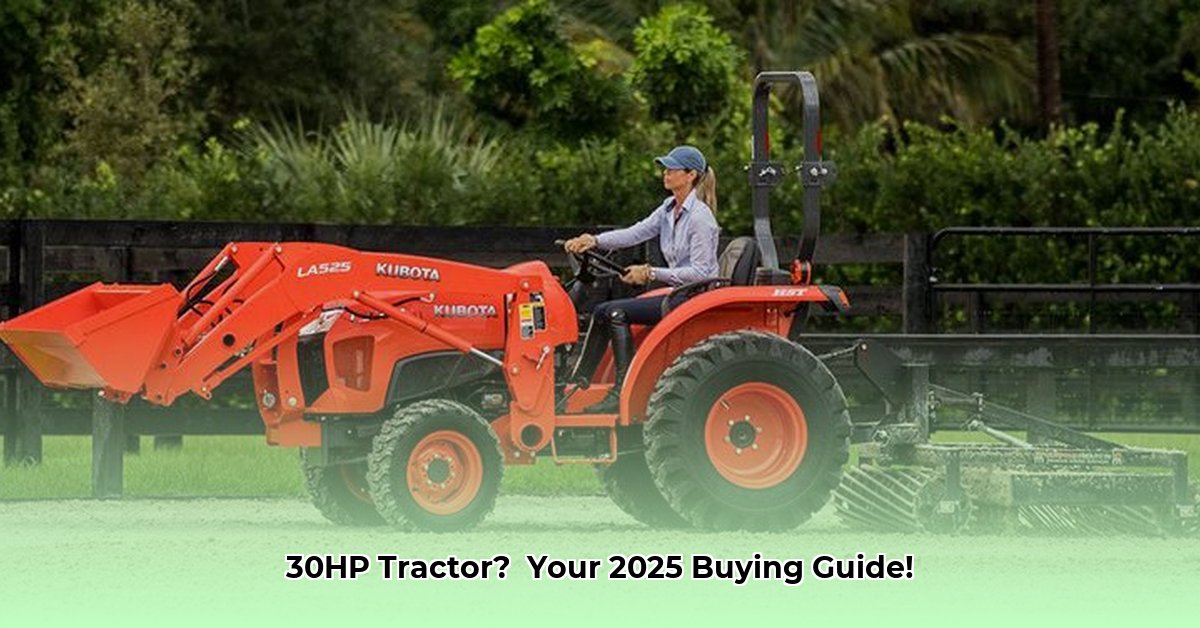
Choosing the right 30-horsepower tractor can be daunting. This comprehensive buyer's guide compares top models, helping you make an informed decision based on your needs and budget, whether you're a homeowner or small farmer. We'll analyze key specifications and provide actionable advice for maximizing your investment. For larger needs, consider a higher horsepower option like those described in this helpful guide.
Understanding 30hp Tractor Specifications: What Matters Most?
The 30hp tractor market offers a diverse range of models from established brands like John Deere and Kubota to other strong contenders. However, horsepower alone doesn't tell the whole story. Several key factors influence a tractor's suitability for various tasks and user profiles.
Engine Power and Transmission Type: Power to the Wheels
Engine power is typically measured in gross horsepower (maximum potential) and PTO (Power Take-Off) horsepower (power delivered to attachments). PTO horsepower is the more relevant metric for determining a tractor's work capacity. For example, a tractor with 30 gross horsepower might have only 25 PTO horsepower. This is vital for tasks requiring significant power like tilling or mowing large areas.
Transmission type significantly impacts ease of use and control. Hydrostatic transmissions (HST), like those found in the Mahindra 1626 HST and Massey Ferguson 1735E, provide infinitely variable speeds and smooth operation, ideal for precision tasks. Gear transmissions, while typically more affordable, offer distinct speed settings.
Lift Capacity and Three-Point Hitch: Attachments and Capabilities
The lift capacity, often expressed in pounds, indicates the maximum weight a tractor's three-point hitch can handle. This is crucial for using implements such as loaders, mowers, and tillers. Heavier-duty tasks demand higher lift capacities. The New Holland Boomer 40, for instance, boasts a significantly higher lift capacity than the Massey Ferguson 1735E, making it better suited for heavier attachments.
2025 30hp Tractor Comparison: A Head-to-Head Look
The following table compares key specifications of several popular 30hp tractor models. Note that these are estimates; always refer to the manufacturer's specifications for precise details. Minor discrepancies might exist due to data variations across sources.
| Model | Engine HP (Gross) | PTO HP (Estimate) | Lift Capacity (lbs) | Transmission Type |
|---|---|---|---|---|
| John Deere 3025D | 24.7 | ~20 | Variable | Gear |
| Mahindra 1626 HST | ≈30 | ~25 | Variable | Hydrostatic (HST) |
| Massey Ferguson 1735E | 34 | ~28 | 1598 | Hydrostatic (HST) |
| New Holland Boomer 40 | 34 | ~28 | 2755 | Gear |
Isn't higher horsepower always better? Not necessarily. While more horsepower can be beneficial for demanding tasks, it also impacts fuel consumption and overall cost of ownership.
Choosing the Right Tractor: Matching Needs to Capabilities
Selecting the ideal 30hp tractor hinges on your specific requirements and budget. This section provides guidance based on common user profiles.
Small Farms: Maximizing Efficiency and ROI
For small farms, PTO horsepower and lift capacity are paramount. Consider fuel efficiency, maintenance costs, and the availability of local dealer support for repairs and parts. A reliable dealer network is critical for minimizing downtime.
Suburban Homeowners: Versatility and Ease of Use
Suburban homeowners often prioritize ease of use and versatility. Features like HST transmissions can significantly enhance maneuverability for tasks like landscaping and snow removal. Keep in mind that ease of maintenance is key for long-term ownership. A simpler machine might be more cost-effective in the long run.
Larger Operations (Near 30hp Limit): Power and Capacity
For operations pushing the limits of 30hp, models like the New Holland Boomer 40 (slightly above 30hp) may be worthwhile considering. Its higher lift capacity caters to more demanding applications.
Total Cost of Ownership (TCO): A Long-Term Perspective
The initial purchase price is only one piece of the puzzle. To accurately assess value, you must factor in the total cost of ownership (TCO) over the tractor's lifespan. This includes:
- Initial Purchase Price: Shop around for the best deals from various dealers.
- Financing Costs: Include interest and repayment terms if financing.
- Maintenance Costs: Budget for regular servicing, oil changes, and filter replacements.
- Fuel Consumption: Consider fuel costs over the tractor's expected life.
- Repair Costs: Account for potential repairs and any warranty coverage.
- Insurance: Include tractor insurance in your calculations.
- Depreciation: Tractors depreciate over time; this is a less concrete factor but still relevant.
By thoroughly evaluating TCO, you can identify the tractor that offers the best value for your investment.
Actionable Steps for Choosing Your Tractor
- Define Your Needs: Create a list of tasks the tractor must perform.
- Set a Budget: Determine your maximum spending limit, including TCO.
- Research Models: Compare specifications and features of different models.
- Visit Dealers: Test drive tractors and discuss servicing options.
- Calculate TCO: Estimate total costs over several years for each model.
- Make Your Decision: Select the tractor that best meets your needs and budget.
This guide provides a foundation for making an informed choice. Remember to consult manufacturer specifications and independent reviews before finalizing your purchase. The information presented here is subject to change as technology advances and the tractor market evolves.